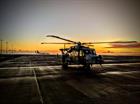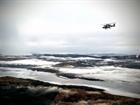COMMANDO WILDCATS STRIKE DURING LIVE WEAPONS SHOOT IN SCOTLAND
Commando fliers hit the ranges in Scotland to ‘lay down some lead’ and call in air strikes.
Wildcats from 847 Naval Air Squadron, which provides battlefield support for the Royal Marines, used exercise areas on the Moray Firth to enhance their ability to bring down a hail of explosive firepower by day and night.
Among a range of battlefield functions, the squadron’s Wildcats provide close air support either with the M3M .50 heavy machine-gun in the rear of the helicopter – it can deliver 1,100 rounds per minute with devastating effect on enemy forces – or by calling in air strikes.
For that it requires a qualified Forward Air Controller (Airborne) – perhaps the most challenging role aircrew train for, as the pilot must coordinate the safety of other helicopters, drones and fast jets, and integrate them with indirect fire, all in close proximity to friendly forces on the ground.
A couple of months after guiding F-35 jets from HMS Queen Elizabeth on bombing runs at Garvie Island off Cape Wrath, the squadron flew north from its home at RNAS Yeovilton to RAF Lossiemouth.
From there it’s just a short flight across the Moray Firth to RAF Tain, a former air base which now serves one of the few live weapons ranges in the UK – 2,300 acres of land which includes static and moving targets and a mock village for aircraft to attack.
With Joint Terminal Attack Controllers – troops who call in air strikes from the ground – occupying the observation tower at Tain, the Wildcats called in repeated strikes from RAF Typhoons, Diamond Twin Stars (propeller-driven close air support trainers) and other Wildcats on 150 occasions, assisting troops exercising on the ground, including shooting 10,000 rounds of .50 ammo.
Exercise Terminal Strike wasn’t just a test for the fliers, but also the men and women supporting them on the ground – assessing their ability to deploy at short notice anywhere in the world.
So for 72 hours they pitched camp in a forward operating base – a cluster of tents inside the wire at Lossiemouth.
Engineers carried out maintenance in weather approaching zero degrees and some fine Scottish rain.
With only minimal supporting equipment to power their mission planning systems, the detachment proved that the Commando Wildcat can operate in unforgiving environments – and be truly expeditionary in nature.
That aside, the detachment returned to base in Somerset with two more personnel qualified as airborne Forward Air Controllers, and a third re-validated for another 12 months.




